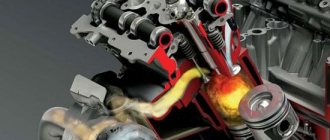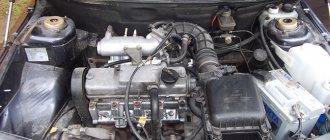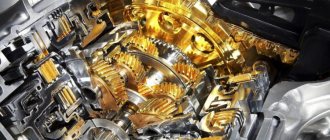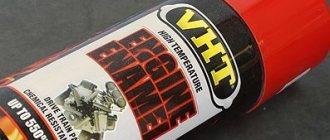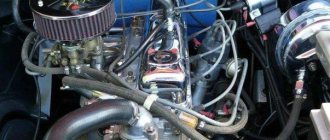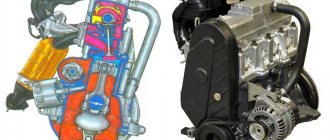One of the most important characteristics of any gasoline or diesel engine is its displacement. Since the appearance of the first internal combustion engines, this characteristic of the engine has been the primary indicator by which one or another power unit is distinguished. For this reason, the concept of “engine displacement” is constantly used in relation to various power plants. On many cars, the engine size is indicated in the form of a special nameplate next to the designation of the model itself. For example, BMW 740 means that it is the seventh series in the model range with an engine capacity of 4.0 liters.
The power characteristics, maximum vehicle speed, etc. greatly depend on the working volume of an atmospheric or turbocharged engine. Moreover, the division of cars into classes, the formation of taxation and the determination of the amount of payment of various fees also takes into account the type of engines and volumes that are installed by the manufacturer for different models/types of vehicles and other vehicles.
We also recommend reading the article about the service life of a modern diesel engine compared to a gasoline engine. From this article you will learn about the main factors and features that affect the service life before the first major overhaul of gasoline and diesel fuel units.
It should be noted that many consumers are not always well aware of what engine displacement actually is. Next, we intend to talk about what makes up the working volume of an internal combustion engine, how to find out the engine size, etc.
What is engine displacement
An internal combustion heat engine is an impressive complex of various mechanisms, systems and additional attachments, forming a complex engineering solution. The general principle of operation of an internal combustion engine involves supplying fuel and air to a special closed chamber, where the resulting fuel-air mixture ignites.
As a result of fuel combustion, energy is released, which pushes the piston located in the engine cylinder. The piston moves, the crankshaft converts the reciprocating motion of the piston into rotational motion, which allows the crankshaft to rotate. Next, the engine torque is transmitted to the transmission and then to the drive wheels of the car.
This process is constantly repeated after starting the engine, that is, the engine is running all the time, provided that the components are supplied and the fuel mixture is efficiently burned in the working chamber. This chamber is called the combustion chamber. The volume of the combustion chamber (also known as the working volume) is the product of the cross-sectional area of the cylinder and the length of the piston stroke from BDC to TDC (top and bottom dead center of the piston stroke). The physical volume of the combustion chamber is the working volume of the engine in gasoline and diesel cars, motorcycles and other types of land, air or water transport, agricultural machinery, as well as other mechanisms and devices using internal combustion engines.
Please note that if the engine has several cylinders, then the volume of the combustion chamber in each of them must be summed up with the others. In other words, the working volume of a multi-cylinder engine is the sum of the volume of the combustion chambers of all cylinders of such an engine. The total volume of all engine cylinders is usually expressed in liters. The working volume of the combustion chamber is indicated in cubic centimeters.
Let's look at this statement using the example of a widely used four-cylinder 2.0-liter internal combustion engine. We will not give exact figures, but simply imagine that each of the combustion chambers has a working volume of 498 cubic centimeters. Since the engine has 4 cylinders, we need to add up the volumes of all cylinders. The result is 1992 cm³. If we talk about internal combustion engines, then to determine the volume, rounding to whole numbers has become the generally accepted standard, and this happens upward. Thus, an engine with the total volume of all combustion chambers, which is actually equal to 1992 cm³, is an engine with a displacement of 2 liters, that is, a two-liter engine.
A little theory
Engine size plays a big role in car design. For this reason, engineers have introduced special documentation that characterizes a very specific classification of engines according to this indicator and focuses on the ratio of power and volume in the case of modern gasoline and diesel internal combustion engines.
Motors of small motorcycles or cars with low weight and dimensions have a minimum volume. Usually the volume in such cases does not exceed a thousand cubic centimeters or slightly more than this unit. This allows you to achieve fairly low fuel consumption with low power, which, nevertheless, is quite enough for comfortable movement around the city and beyond.
Further classification of engines involves units whose volume reaches no more than two thousand cubic centimeters. Such engines are installed on the vast majority of passenger cars that are currently supplied to the market. If a couple of decades ago we were talking only about atmospheric units, today turbines have also begun to be widely installed. This made it possible to talk about higher powers and technical data, which previously only possessed larger engines.
The most powerful engines are supplied for sports cars and SUVs, as well as for large equipment. Such internal combustion engines are the most voracious and have a lot of weight. Nevertheless, they have a good resource and allow you to move quickly and comfortably in a car whose weight is quite large.
How cars are divided into classes based on engine size
The model range of each manufacturer contains products that differ in class, weight, overall dimensions and other characteristics. As for passenger cars, during the total dominance of atmospheric gasoline engines, there was a conditional division into:
- subcompact and compact mini and subcompact cars with a displacement of up to 1.2 liters;
- small class cars with engines from 1.2 to 1.8 liters;
- middle class with a volume from 1.8 to 3.5 liters.
- powerful civilian and sports versions of cars with engines of 3.5 liters or more;
- high-end versions, which can have different internal combustion engine volumes.
Let's take a look at what engine size affects. The installation of a particular motor on a specific model directly depends on what characteristics the car should demonstrate (acceleration dynamics, torque, maximum speed, etc.). The power indicator depends on the engine volume due to the fact that the more fuel is burned in the combustion chamber per cycle, the more energy is released and transferred to the piston. In other words, the larger the combustion chamber, the more fuel-air mixture can be supplied and accommodated there. Acceleration dynamics and maximum speed also depend on engine power. The more powerful the engine, the greater the speed the car can develop. It should also be taken into account that increasing the volume of the chambers automatically means greater fuel consumption.
It should be added that the price of the car greatly depends on the engine size. For example, for the production of a powerful V12 engine with a volume of 5.5 liters. Much higher costs are required compared to the manufacture of a three-cylinder engine with a volume of 0.8 liters. In parallel with this, it should be taken into account that installing a powerful power unit under the hood will entail the need for serious modifications to the transmission, cooling system, intake, exhaust, braking system, etc.
Based on the above, small budget city runabouts are often equipped with internal combustion engines with the smallest volume, since such engines are easy to manufacture, provide acceptable dynamics and have low fuel consumption. At the same time, the price for such production cars remains acceptable.
Negative aspects of an overly voluminous power unit
Many positive features of using a displacement engine were mentioned above. But there are also certain disadvantages from buying a car with such a power unit. Of course, it is difficult to compare them with the advantages, because their number is an order of magnitude smaller, but it would not be too fair not to indicate them in the publication. The main disadvantages of using a car with a displacement engine are as follows:
- noticeably high fuel consumption - often it exceeds 15-17 liters in city mode;
- a certain oil consumption - about 0.7-1 liters of lubricant burns out per 1000 kilometers;
- high demands on filters, as well as lubricant and coolant;
- quite expensive maintenance and very expensive repairs if necessary.
Despite the high cost of repairs, this engine actually never needs such work. But if you have already driven about 500 thousand kilometers on such a unit, it’s time to think about changing the car, because otherwise you may soon face expensive maintenance with replacement of engine spare parts. There are, of course, excessively large volumes when the design of the machine simply cannot cope with the tasks of the engine, as in the following video:
Why are modern model designations not tied to engine size?
After the active introduction of turbo engines into the market in the form of turbodiesel and turbopetrol engines, the situation has changed somewhat, both in the entry-level and middle class, and in the premium segment. Let's start with the fact that it has become more difficult to navigate by the “nameplates” on a car. Initially, many automakers developed such an alphanumeric index that clearly corresponded to the model and engine size. For example, BMW 535 (5-series with a volume of 3.5).
Today, a powerful model with a 5.0-liter naturally-aspirated engine, after installing a turbine, receives a volume of 4.4 liters, but is still designated the same as the previous one. This situation is well illustrated by the fact that the digital designation of a popular Mercedes-Benz model lost its connection to engine size. We are talking about the 63rd AMG. Under the hood of the model has long been installed not a naturally aspirated unit with a volume of 6.2 liters, but a biturbo engine with a displacement of 5.5 liters. However, the car is still called Mercedes 63 AMG.
Let us add that today you can find a highly accelerated engine with a displacement of only 1 liter. (for example, engines of the Ecoboost line on Ford models), which can be installed on a mid-size sedan or hatchback of the “C” / “D” class. The fact is that the installation of turbocharging made it possible to provide such characteristics when the efficiency, power and torque of the engine became possible to significantly increase without the need to increase the physical volume of the combustion chamber.
In other words, the naturally aspirated 1.6 has 115 hp, while the 1.0-liter Ecoboost produces a whopping 125 hp. In parallel with this, the torque of turbo engines is higher and is available from the very bottom, while naturally aspirated engines need to be turned to medium speeds to obtain acceptable dynamics.
We also recommend reading the article about what a boosted engine is. From this article you will learn about ways to increase the power of an atmospheric or turbocharged internal combustion engine.
OPTIMUM DISPLACEMENT
Almost all manufacturers offer several engines for the same car model, and choosing the optimal engine is not always easy. Conventionally, cars are divided into several classes:
- minicars, with an engine capacity of no more than 1100 cubic meters. cm;
- small-capacity, with a volume of 1200 - 1700 cubic meters. cm;
- mid-displacement, with a volume of 1800 - 3500 cubic meters. cm;
- large-capacity, with a volume of more than 3500 cubic meters. cm.
There is a gradation of power units by car class. For class B cars, engines from 1.0 to 1.6 liters are usually offered, C-class is equipped with engines with a volume of 1.4 to 2 liters, D-class - 1.6 - 2.5 liters, E-class - from 2 liters When choosing a suitable engine for himself, the future car owner must determine in what conditions the car will be primarily used. For driving in urban conditions, a motor with a smaller displacement (for example, 1.4 liters) is quite suitable if it has good traction at low speeds. If there is insufficient traction at the bottom, the engine will have to be constantly “twisted”, and you can forget about the promised eight liters of fuel per 100 km in the city.
It is also necessary to take into account that the switched on air conditioning system takes up a significant part of the power and increases fuel consumption. In this case, driving a car with a low-power engine becomes unpleasant, since the driver will constantly be forced to engage lower gears.
If the car will primarily be used on the highway, it is better to choose a larger engine.
- Firstly, the difference in consumption will not be so significant;
- secondly, under the hood of the car there will always be a reserve of power, which will allow the driver to overtake more confidently;
- In addition, turning on the air conditioning or climate control system has virtually no effect on the dynamics of the car.
Increase in engine displacement
Physically increasing the volume of the combustion chamber is one of the ways to boost the engine in order to increase power. Let's start with the fact that it is not possible to greatly increase the volume, since the engine cylinder block is usually designed to bore the cylinders themselves strictly to certain limits. Such limits require 3 major overhauls, during which worn cylinders are bored out to return them to the correct shape before installing repair pistons, piston rings and other oversized elements.
Pistons and other engine parts that are available for sale are also found exclusively in three overhaul sizes. For this reason, during deep tuning of a car engine, it is better to immediately change the engine, that is, install another engine with an initially large displacement, which can then be additionally bored to the second or final repair size.
Car design for dummies
- The history of the creation of the first cars
- Structure of a car for dummies Purpose of a car
- General structure of the car
- Car engine structure Engine operation Engine operating cycle
- Cylinder displacement
- Duty cycle of a four-stroke engine

